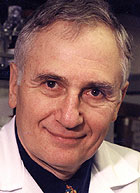Scientists are closing in on the solution to a persistent medical puzzle: why do high doses of cortisone, widely prescribed for asthma, rheumatoid arthritis and other conditions, weaken bones?

Through studies of mice, School of Medicine researchers now have identified osteoclasts, cells that dismantle old bone, as the essential link between osteoporosis and cortisone. As scientists flesh out the molecular-level details of this connection, they may be able to identify targets for therapy to prevent cortisone’s damaging side effects on bone.
“High-dose cortisone is the second most common cause of osteoporosis, and we currently have no real treatment for this serious side effect,” said senior author Steven L. Teitelbaum, M.D., the Messing Professor of Pathology and Immunology. “Given how frequently these drugs are used to treat many different conditions, that’s a major clinical problem.”
Teitelbaum and colleagues, including lead author Hyun-Ju Kim, Ph.D., a postdoctoral fellow, published their results in the August issue of the Journal of Clinical Investigation.
Cortisone is a steroid produced naturally by the adrenal gland and synthesized by a number of pharmaceutical companies for clinical use. The drug is also used to treat lupus, multiple sclerosis and chronic obstructive pulmonary disease, and it is prescribed to transplant patients to prevent rejection of transplanted organs.
Earlier attempts to identify the connection between bone loss and cortisone produced seemingly contradictory results. In prior lab animal experiments, researchers found cortisone caused bone-building osteoblast cells to self-destruct, suggesting that cortisone disrupts the body’s ability to form new bone after it is naturally dismantled by osteoclasts. However, experiments in a test tube also showed cortisone stimulates bone formation.
Teitelbaum identified a new opportunity to explore the conundrum while at a lecture by Louis J. Muglia, M.D., Ph.D., professor of obstetrics and gynecology, of pediatrics and of molecular biology and pharmacology. Muglia’s group studies the health effects of stress, many of which are mediated by cortisone. To aid in his research, Muglia de-veloped a line of genetically modified mice where receptors for cortisone, which are found throughout the body, could be selectively eliminated in individual cell types.
By crossbreeding their genetically modified mouse lines, researchers produced a line of mice whose bone-dismantling osteoclasts lacked cortisone receptors. When researchers gave cortisone to these mice, the bone-weakening effects of the drugs were blocked.
Scientists also found that cortisone inhibits the ability of osteoclasts to dismantle old bone in genetically normal mice. This blockage might seem to leave bones free to retain their strength, but with the regular skeletal renewal process stopped, bones will weaken dramatically from aging and stress. Dampening of osteoclast activity may also cause a chain reaction that slows activity of bone-building osteoblasts.